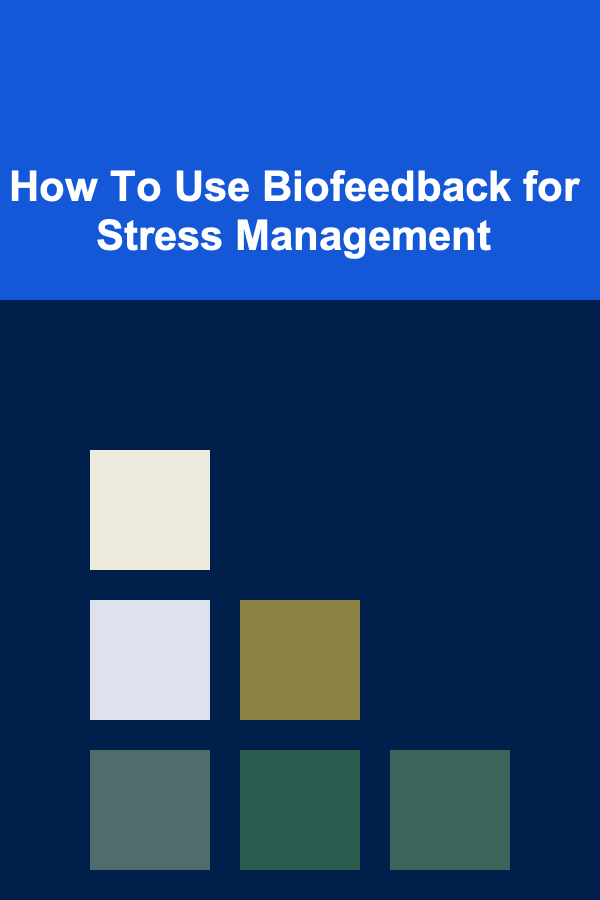
How To Use Biofeedback for Stress Management
ebook include PDF & Audio bundle (Micro Guide)
$12.99$9.99
Limited Time Offer! Order within the next:

Stress is a part of everyday life, but when it becomes chronic, it can significantly impact mental, emotional, and physical well-being. Many people find themselves trapped in a cycle of stress without realizing its long-term consequences. As stress affects the body in multiple ways, it is essential to adopt effective strategies for managing it. One of the most promising approaches for stress management is biofeedback, a technique that involves using real-time data from the body to gain better control over stress responses. This article explores biofeedback, its mechanisms, types, and its application for stress management.
What is Biofeedback?
Biofeedback is a technique that allows individuals to monitor physiological functions that are typically automatic, such as heart rate, breathing, muscle tension, and skin temperature. Using sensors attached to the body, biofeedback devices measure these biological signals, and the feedback is presented in real time through visual or auditory cues. By becoming aware of these physiological responses, individuals can learn to control them consciously, promoting relaxation and improving overall health.
Biofeedback has been used in a variety of therapeutic settings, from managing pain and anxiety to aiding in the treatment of hypertension and insomnia. The ultimate goal of biofeedback is to help individuals develop self-regulation skills, which can be particularly useful for managing stress.
The Science Behind Biofeedback
At the core of biofeedback is the concept of neuroplasticity, the brain's ability to reorganize itself by forming new neural connections. When we experience stress, our body reacts automatically through the activation of the sympathetic nervous system, often referred to as the "fight-or-flight" response. This reaction can lead to increased heart rate, shallow breathing, muscle tension, and a variety of other stress-related symptoms.
Through biofeedback, individuals are trained to recognize these stress signals and, over time, learn to control them by influencing the parasympathetic nervous system---the "rest-and-digest" response. By consciously controlling their physiological responses, individuals can reduce the negative impact of stress on their bodies and minds.
Types of Biofeedback
There are several types of biofeedback that target different physiological functions. Each type uses sensors to measure specific bodily processes and provides real-time feedback to help individuals regulate those processes. The most common types of biofeedback used for stress management include:
1. Heart Rate Variability (HRV) Biofeedback
HRV biofeedback focuses on monitoring the heart rate and its variability. Heart rate variability refers to the variation in time between consecutive heartbeats. A high HRV indicates a healthy, responsive autonomic nervous system, while low HRV can be a sign of stress, poor health, or even an increased risk of cardiovascular disease.
Through HRV biofeedback, individuals learn to synchronize their breathing with their heart rate to achieve optimal HRV levels. By improving HRV, individuals can promote a relaxed state and enhance their resilience to stress.
2. Electromyography (EMG) Biofeedback
EMG biofeedback involves measuring muscle tension, particularly in the face, neck, and shoulders, which are common areas where stress manifests. EMG sensors detect electrical activity in the muscles, providing feedback about areas of tightness or tension. The goal is to help individuals become aware of unconscious muscle contractions and teach them how to relax those muscles.
Reducing muscle tension can lower stress levels and alleviate related symptoms, such as headaches, neck pain, and jaw clenching.
3. Temperature Biofeedback
Temperature biofeedback measures skin temperature, often focusing on the fingers or toes. When stressed, blood flow to the extremities decreases, causing the skin temperature to drop. By learning to raise their skin temperature through relaxation techniques, individuals can activate the parasympathetic nervous system, reduce stress, and promote a calm, relaxed state.
This type of biofeedback can be especially effective for people who experience stress-related conditions such as cold hands, migraines, or Raynaud's disease.
4. Galvanic Skin Response (GSR) Biofeedback
GSR biofeedback measures the electrical conductance of the skin, which changes with sweat gland activity. When the body is stressed, the sympathetic nervous system activates sweat glands, leading to an increase in skin conductance. By using GSR biofeedback, individuals can monitor their sweat levels and learn to control their response to stressors.
GSR biofeedback can be particularly useful for managing anxiety, improving relaxation, and gaining awareness of emotional responses to stress.
How Biofeedback Helps with Stress Management
Biofeedback is a powerful tool for stress management because it empowers individuals to take control of their own physiological responses. The primary ways in which biofeedback helps manage stress are:
1. Increased Awareness of Stress Responses
One of the key benefits of biofeedback is that it makes individuals more aware of how their body responds to stress. Often, stress manifests in subtle ways that we are not consciously aware of, such as a slight increase in heart rate or muscle tension. Biofeedback helps individuals recognize these early signs of stress, enabling them to take proactive steps to manage their stress before it escalates.
2. Training the Body to Relax
Biofeedback teaches individuals specific techniques to reduce stress, such as deep breathing, progressive muscle relaxation, and visualization. By using real-time feedback, individuals can practice these techniques and observe their effects on their physiological responses. With repeated practice, they can improve their ability to induce relaxation on their own, even in high-stress situations.
3. Enhancing Self-Regulation
The goal of biofeedback is to help individuals develop self-regulation skills, allowing them to manage their physiological responses to stress without external intervention. Over time, as individuals gain more control over their stress responses, they can use biofeedback less frequently, as their ability to relax and manage stress becomes more ingrained.
4. Reducing Anxiety and Enhancing Mental Clarity
Stress often leads to anxiety, which can impair decision-making and mental clarity. By learning how to manage physiological stress responses through biofeedback, individuals can reduce anxiety and improve their ability to think clearly. This can be particularly beneficial in high-pressure situations, such as work-related stress or public speaking.
5. Improving Overall Health
Chronic stress can lead to a variety of health issues, such as high blood pressure, digestive problems, and sleep disturbances. By using biofeedback to manage stress, individuals can improve their overall health and reduce the risk of stress-related conditions. Biofeedback has also been shown to improve immune system function, lower cortisol levels, and promote better sleep quality.
Biofeedback Training and Implementation for Stress Management
To effectively use biofeedback for stress management, individuals need to undergo training with a qualified professional. Biofeedback training typically involves the following steps:
1. Initial Assessment
During the first session, a biofeedback practitioner will conduct an assessment to determine which physiological signals are most relevant for managing the individual's stress. This may involve measuring heart rate, muscle tension, skin temperature, and other variables to establish a baseline.
2. Setting Goals
The next step is to establish specific goals for the biofeedback training. These goals might include reducing muscle tension, improving HRV, or learning to control skin conductance. The practitioner and the individual will work together to define measurable goals that can be tracked over time.
3. Training Sessions
During training sessions, individuals will be connected to biofeedback equipment that provides real-time feedback on their physiological responses. Through guided exercises, such as deep breathing or progressive muscle relaxation, individuals will learn how to influence their physiological responses to stress. The feedback serves as reinforcement, helping individuals refine their techniques.
4. Home Practice
In addition to training sessions, individuals are typically encouraged to practice biofeedback techniques at home. Many biofeedback devices are portable and can be used outside of the clinical setting, allowing individuals to continue practicing stress management techniques on their own.
5. Ongoing Support
Biofeedback training is often an ongoing process, with practitioners offering regular check-ins and support as individuals continue to refine their stress management skills. Over time, as individuals gain confidence in their ability to manage stress, they may need less frequent biofeedback sessions.
Benefits of Biofeedback for Stress Management
The benefits of using biofeedback for stress management extend beyond just relaxation. Some of the most notable advantages include:
1. Non-Invasive and Drug-Free
Biofeedback is a non-invasive, drug-free approach to stress management. Unlike medications or other treatments that may come with side effects, biofeedback allows individuals to take a natural approach to managing stress.
2. Empowerment and Self-Control
One of the most significant benefits of biofeedback is the empowerment it offers individuals. By learning to control their physiological responses, individuals take an active role in their health and well-being. This sense of control can help reduce feelings of helplessness and anxiety.
3. Long-Term Stress Management
Unlike quick-fix solutions, biofeedback teaches individuals skills that can be applied throughout their lives. By developing the ability to manage stress effectively, individuals are better equipped to handle life's challenges and maintain their mental and physical health over the long term.
4. Improved Mental and Emotional Well-Being
Through biofeedback, individuals can achieve a sense of inner calm and balance. The ability to manage stress leads to improved emotional regulation, less anxiety, and a better overall sense of well-being. These improvements can have a profound impact on relationships, work performance, and overall quality of life.
Conclusion
Biofeedback offers a powerful and effective approach to managing stress. By providing real-time feedback on physiological responses, biofeedback allows individuals to gain greater control over their stress levels and enhance their resilience. Through training and practice, biofeedback can empower individuals to develop self-regulation skills that promote relaxation, reduce anxiety, and improve overall health. As a non-invasive, drug-free method, biofeedback is a valuable tool for anyone looking to manage stress and improve their well-being in the long term.

How to Create a Wedding Day Packing List
Read More
How to Make the Most of Your Home Budget with Simple Adjustments
Read More
How to Organize Your Smartphone Photos Efficiently
Read More
The Warehouse Manager's Guide: Mastering Inventory Management and Operational Efficiency
Read More
How to Make Homemade Nut Milks
Read More
How to Start a Microbrewery or Cidery: A Comprehensive Guide
Read MoreOther Products

How to Create a Wedding Day Packing List
Read More
How to Make the Most of Your Home Budget with Simple Adjustments
Read More
How to Organize Your Smartphone Photos Efficiently
Read More
The Warehouse Manager's Guide: Mastering Inventory Management and Operational Efficiency
Read More
How to Make Homemade Nut Milks
Read More